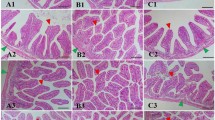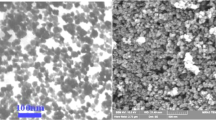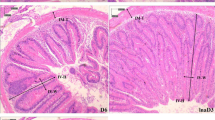Abstract
Mycotoxins, produced by fungi, can contaminate fish food and harm their health. Probiotics enhance immune balance and primarily function in the animal intestine. This study aimed to assess aflatoxin’s impact on Piaractus mesopotamicus and explore probiotic-based additive (PBA) benefits in mitigating these effects, focusing on antioxidant activity, biochemical indices, and hepatic histopathology. Two experiments were conducted using P. mesopotamicus fry. The first experimental assay tested various levels of aflatoxin B1 (0.0, 25.0, 50.0, 100.0, 200.0, and 400.0 µg kg−1) over a 10-day period. The second experimental assay examined the efficacy of the probiotic (supplemented at 0.20%) in diets with different levels of aflatoxin B1 (0.0, 25.0, and 400.0 µg kg−1) for 15 days. At the end of each assay, the fish underwent a 24-hour fasting period, and the survival rate was recorded. Six liver specimens from each treatment group were randomly selected for metabolic indicator assays, including superoxide dismutase, catalase, alanine aminotransferase, aspartate aminotransferase, and albumin. Additionally, histopathological analysis was performed on six specimens. The initial study discovered that inclusion rates above 25.0 µg kg−1 resulted in decreased activity of AST (aspartate aminotransferase), ALT (alanine aminotransferase), ALB (albumin), CAT (catalase), and SOD (superoxide dismutase), accompanied by liver histopathological lesions. In the second study, the inclusion of PBA in diets contaminated with AFB1 improved the activity of AST and ALT up to 25.0 µg kg−1 of AFB1, with no histopathological lesions observed. The study demonstrated the hepatoprotective effects of PBA in diets contaminated with AFB1. The enzyme activity and hepatic histopathology were maintained, indicating a reduction in damage caused by high concentrations of AFB1 (400.0 µg kg−1 of AFB1). The adverse effects of AFB1 on biochemical and histopathological parameters were observed from 25.0 µg kg−1 onwards. Notably, PBA supplementation enhanced enzymatic activity at a concentration of 25 µg kg−1 of AFB1 and mitigated the effects at 400.0 µg kg−1 of AFB1. The use of PBAs in pacu diets is highly recommended as they effectively neutralize the toxic effects of AFB1 when added to diets containing 25.0 µg kg−1 AFB1. Dietary inclusion of aflatoxin B1 at a concentration of 25.0 µg kg−1 adversely affects the liver of Piaractus mesopotamicus (Pacu). However, the addition of a probiotic-based additive (PBA) to the diets containing this concentration of aflatoxin neutralized its toxic effects. Therefore, the study recommends the use of PBAs in Pacu diets to mitigate the adverse effects of aflatoxin contamination.





Similar content being viewed by others
Data availability
No datasets were generated or analysed during the current study. Data can be available upon request.
References
Abdel-Latif HM, Yilmaz E, Dawood MA et al (2022) Shrimp vibriosis and possible control measures using probiotics, postbiotics, prebiotics, and synbiotics: a review. Aquaculture 551:737951. https://doi.org/10.1016/j.aquaculture.2022.737951
Abdel-Wahhab MA, El-Nekeety AA, Hathout AS et al (2020) Secondary metabolites from bacillus sp. merna extract attenuates the oxidative stress, genotoxicity and cytotoxicity of aflatoxin b1 in rats. Food Chem Toxicol 141:111399. https://doi.org/10.1016/j.fct.2020.111399
Afshar P, Shokrzadeh M, Raeisi SN et al (2020) Aflatoxins biodetoxification strategies based on probiotic bacteria. Toxicon 178:50–58. https://doi.org/10.1016/j.toxicon.2020.02.007
Ahmadifar E, Dawood MA, Moghadam MS et al (2020) The effect of pediococcus acidilactici ma 18/5m on immune responses and mrna levels of growth, antioxidant and immune-related genes in zebrafish (danio rerio). Aqua Rep 17:100374. https://doi.org/10.1016/j.aqrep.2020.100374
Ali Rajput S, Sun L, Zhang N et al (2017) Ameliorative effects of grape seed proanthocyanidin extract on growth performance, immune function, antioxidant capacity, biochemical constituents, liver histopathology and aflatoxin residues in broilers exposed to aflatoxin b1. Toxins 9(11):371. https://doi.org/10.3390/toxins9110371
Anater A, Araújo CMTD, Rocha DCC et al (2020) Evaluation of growth performance, hematological. Biochemical and histopathological parameters of Rhamdia quelen fed with a feed artificially contaminated with aflatoxin b1. Aqua Rep 17:100326. https://doi.org/10.1016/j.aqrep.2020.100326
AOAC (2016) Association of Official Analytical Chemists (AOAC), 20th edn. Wiley, Hoboken
Ayyat MS, Ayyat AMN, Al-Sagheer AA et al (2018) Effect of some safe feed additives on growth performance, blood biochemistry, and bioaccumulation of aflatoxin residues of nile tilapia fed aflatoxin-b1 contaminated diet. Aquaculture 495:27–34. https://doi.org/10.1016/j.aquaculture.2018.05.030
Baldissera MD, Souza CF, Zeppenfeld CC et al (2018) Aflatoxin b1-contaminated diet disrupts the blood–brain barrier and affects fish behavior: involvement of neurotransmitters in brain synaptosomes. EnvironToxicol Phar 60:45–51. https://doi.org/10.1016/j.etap.2018.04.003
Bedoya-Serna CM, Michelin EC, Massocco MM et al (2019) Correction: effects of dietary aflatoxin b1 on accumulation and performance in matrinxã fish (Brycon cephalus). PLoS ONE 14(4):e0216194. https://doi.org/10.1371/journal.pone.0216194
Bennett JW, Klich M (2003) Mycotoxins. Clin Microbiol Rev 16(3):497–516. https://doi.org/10.1128/CMR.16.3.497-516.2003
Beutler E (1984) Red cell metabolism. A manual of biochemical methods, 3rd edn. Grune and Stratton, Orlando, Florida
Biomart (2023) Multi Aqua Plus - Aditivo probiótico para peixes e camarões — Biomart. https://biomart.com.br/produtos/multaquaplus.html
Bligh EG, Dyer WJ (1959) A rapid method of total lipid extraction and purification. Can J Biochem Phys 37(1):911–917. https://doi.org/10.1139/y59-099
Bradbury SP, Coats JR (1989) Toxicokinetics and toxicodynamics of pyrethroid insecticides in fish. Environ Toxicol Chem 8(5):373–380. https://doi.org/10.1002/etc.5620080503
Bradford M (1976) A rapid and sensitive method for the quantitation of microgram quantities of protein utilizing the principle of protein-dye binding. Anal Biochem 72(1–2):248–254. https://doi.org/10.1006/abio.1976.9999
Bryden WL (2012) Mycotoxin contamination of the feed supply chain: implications for animal productivity and feed security. Anim Feed Sci Tech 173(1–2):134–158. https://doi.org/10.1016/j.anifeedsci.2011.12.014
Bueno DJ, Casale CH, Pizzolitto RP et al (2007) Physical adsorption of aflatoxin b1 by lactic acid bacteria and Saccharomyces cerevisiae: a theoretical model. J Food Protect 70(9):2148–2154. https://doi.org/10.4315/0362-028x-70.9.2148
Carmo Ota E, Honorato CA, Heredia-Vieira SC et al (2019) Hepatic and gastroprotective activity of serjania marginata leaf aqueous extract in nile tilapia (Oreochromis niloticus). Fish Physiol Biochem 45(3):1051–1065. https://doi.org/10.1007/s10695-019-00622-9
Carvalho WLd, Maioli MA, Mendes LCN et al (2013) Mecanismos Da intoxicação do fígado de rato causada pelo gossipol. Pesq Vet Bras 33(3):339–344. https://doi.org/10.1590/s0100-736x2013000300011
Cren EDL (1951) The length-weight relationship and seasonal cycle in gonad weight and condition in the perch (perca fluviatilis). J Anim Ecol 20(2):201. https://doi.org/10.2307/1540
Da Silva E, Bracarense AP, Oswald IP (2018) Mycotoxins and oxidative stress: where are we? World Mycotoxin J 11(1):113–134
Dawood MA, Eweedah NM, Moustafa EM et al (2020) Probiotic effects of aspergillus oryzae on the oxidative status, heat shock protein, and immune related gene expression of nile tilapia (oreochromis niloticus) under hypoxia challenge. Aquaculture 520:734669. https://doi.org/10.1016/j.aquaculture.2019.734669
Di Natale F, Gallo M, Nigro R (2009) Adsorbents selection for aflatoxins removal in bovine milks. J Food Eng 95(1):186–191. https://doi.org/10.1016/j.jfoodeng.2009.04.023
El-Saadony MT, Alagawany M, Patra AK et al (2021) The functionality of probiotics in aquaculture: an overview. Fish Shellfish Immunol 117:36–52. https://doi.org/10.1016/j.fsi.2021.07.007
Elliott CT, Connolly L, Kolawole O (2019) Potential adverse effects on animal health and performance caused by the addition of mineral adsorbents to feeds to reduce mycotoxin exposure. Mycotoxin Res 36(1):115–126. https://doi.org/10.1007/s12550-019-00375-7
Faucet-Marquis V, Joannis-Cassan C, Hadjeba-Medjdoub K et al (2014) Development of an in vitro method for the prediction of mycotoxin binding on yeast-based products: case of aflatoxin b1, zearalenone and ochratoxin a. Appl Microbiol Biotechnol 98(17):7583–7596. https://doi.org/10.1007/s00253-014-5917-y
Favero G, Gimbo RY, Montoya LNF et al (2020) A fasting period during grow-out make juvenile pacu (Piaractus mesopotamicus) leaner but does not impair growth. Aquaculture 524:735242. https://doi.org/10.1016/j.aquaculture.2020.735242
Fonseca NBS, Gadelha ICN, Oloris SCS et al (2013) Effectiveness of albumin- conjugated gossypol as an immunogen to prevent gossypol-associated acute hepatotoxicity in rats. Food Chem Toxicol 56:149–153. https://doi.org/10.1016/j.fct.2013.02.010
Freitas Souza C, Baldissera MD, Baldisserotto B et al (2020) Dietary vegetable choline improves hepatic health of nile tilapia (Oreochromis niloticus) fed aflatoxincontaminated diet. Comp Biochem Physiol C: Toxicol Pharmacol 227:108614. https://doi.org/10.1016/j.cbpc.2019.108614
Fuchs S, Sontag G, Stidl R et al (2008) Detoxification of patulin and ochratoxin a, two abundant mycotoxins, by lactic acid bacteria. Food Chem Toxicol 46(4):1398–1407. https://doi.org/10.1016/j.fct.2007.10.008
Fuentes-Quesada JP, Viana MT, Rombenso AN et al (2018) Enteritis induction by soybean meal in totoaba macdonaldi diets: effects on growth performance, digestive capacity, immune response and distal intestine integrity. Aquaculture 495:78–89. https://doi.org/10.1016/j.aquaculture.2018.05.025
Gallagher E, Eaton D (1995) In vitro biotransformation of aflatoxin b1 (afb1) in channel catfish liver. Toxicol App Pharm 132(1):82–90. https://doi.org/10.1006/taap.1995.1089
Galvano F, Piva A, Ritieni A et al (2001) Dietary strategies to counteract the effects of mycotoxins: a review. J Food Protect 64(1):120–131
Ghafarifarsani H, Imani A, Niewold TA et al (2021a) Synergistic toxicity of dietary aflatoxin b1 (afb1) and zearalenone (zen) in rainbow trout (oncorhynchus mykiss) is attenuated by anabolic effects. Aquaculture 541:736793. https://doi.org/10.1016/j.aquaculture.2021.736793
Ghafarifarsani H, Kachuei R, Imani A (2021b) Dietary supplementation of garden thyme essential oil ameliorated the deteriorative effects of aflatoxin b1 on growth performance and intestinal inflammatory status of rainbow trout (oncorhynchus mykiss). Aquaculture 531:735928. https://doi.org/10.1016/j.aquaculture.2020.735928
Gonçalves RA, Do Cam T, Tri NN et al (2018) Aflatoxin b1 (afb1) reduces growth performance, physiological response, and disease resistance in tra catfish (Pangasius hypophthalmus). Aquacult Int 26(3):921–936. https://doi.org/10.1007/s10499-018-0259-x
Gong YY, Wilson S, Mwatha JK et al (2012) Aflatoxin exposure may contribute to chronic hepatomegaly in Kenyan school children. Environ Health Persp 120(6):893–896. https://doi.org/10.1289/ehp.1104357
Gratz S, Wu QK, El-Nezami H et al (2007) Lactobacillus rhamnosus strain Gg reduces aflatoxin b1 transport, metabolism, and toxicity in caco-2 cells. Appl Environ Microb 73(12):3958–3964. https://doi.org/10.1128/aem.02944-06
Haskard CA, El-Nezami HS, Kankaanpaa PE et al (2001) Surface binding of aflatoxin b1 by lactic acid bacteria. Appl Environ Microb 67(7):3086–3091
Honorato CA, da Silva CJ, Flores-Quintana CI et al (2017) Jatropha cake (Jatropha curcas): hepatotoxic implications. Braz J Vet Res Anim Sci 54(2):101–108. https://doi.org/10.11606/issn.1678-4456.bjvras.2017.79390
Hoseyni SZ, Imani A, Vazirzadeh A et al (2024) Dietary aflatoxin b1 and zearalenone contamination affected growth performance, intestinal and hepatopancreas gene expression profiles and histology of the intestine and gill in goldfish, carassius auratus. Aqua Rep 34:101887. https://doi.org/10.1016/j.aqrep.2023.101887
Imani A, Salimi Bani M, Noori F et al (2017) The effect of bentonite and yeast cell wall along with cinnamon oil on aflatoxicosis in rainbow trout (Oncorhynchus mykiss): Digestive enzymes, growth indices, nutritional performance and proximate body composition. Aquaculture 476:160–167. https://doi.org/10.1016/j.aquaculture.2017.04.023
Kebede H, Liu X, Jin J et al (2020) Current status of major mycotoxins contamination in food and feed in Africa. Food Control 110:106975. https://doi.org/10.1016/j.foodcont.2019.106975
Klein S, Lorenz E, Bueno G et al (2014) Levels of crude protein in diets for pacu (Piaractus mesopotamicus) from 150 to 400 g reared in cages. Arch Zootec 63(244):599–610. https://doi.org/10.4321/s0004-05922014000400004
Kolo RJ, Lamai SL, Ojutiku RO (2010) Subacute toxicity of karate to Sarotherodon Galilieus (linne, 1758). J Water ChemTechno + 32 2107–112. https://doi.org/10.3103/s1063455x10020074
Kruger NJ (2009) The Bradford method for protein quantitation. In: The protein protocols handbook, 3rd edn, Chap 4th. Humana, Totowa, pp 17–24. https://doi.org/10.1007/978-1-59745-198-7
Levene H (1960) Robust tests for equality of variances. In: Olkin I (ed) Contributions to probability and statistics. Stanford University Press, Palo Alto, pp 278–292
Lima-Junior SE, Cardone IB, Goitein R (2002) Determination of a method for calculation of allometric condition factor of fish. Acta Scientiarum Biol Health Sci 24(2):397–400. https://doi.org/10.4025/actascibiolsci.v24i0.2311
Mahfouz ME, Sherif AH (2015) A multiparameter investigation into adverse effects of aflatoxin on Oreochromis niloticus health status. J Basic Appl Zool 71:48–59. https://doi.org/10.1016/j.jobaz.2015.04.008
Marin DE, Taranu I (2012) Overview on aflatoxins and oxidative stress. Toxin Rev 31(3–4):32–43. https://doi.org/10.3109/15569543.2012.730092
Martinez MP, Gonzalez Pereyra ML, Pena GA et al (2017) Pediococcus acidolactici and Pediococcus pentosaceus isolated from a rainbow trout ecosystem have probiotic and abf1 adsorbing/degrading abilities in vitro. Food Addit Contam A 34(12):2118–2130. https://doi.org/10.1080/19440049.2017.1371854
Martínez Cruz P et al (2012) Use of probiotics in aquaculture. Int Sch Res Not 2012. https://doi.org/10.5402/2012/916845
Matejova I, Svobodova Z, Vakula J et al (2016) Impact of mycotoxins on aquaculture fish species: a review. J World Aquacult Soc 48(2):186–200. https://doi.org/10.1111/jwas.12371
Michelin EC, Massocco MM, Godoy SHS et al (2016) Carryover of aflatoxins from feed to lambari fish (Astyanax altiparanae) tissues. Food Addit Contam A 1–8. https://doi.org/10.1080/19440049.2016.1266097
Modesto KA, Martinez CB (2010) Roundup® causes oxidative stress in liver and inhibits acetylcholinesterase in muscle and brain of the fish Prochilodus lineatus. Chemosphere 78(3):294–299. https://doi.org/10.1016/j.chemosphere.2009.10.047
Neme K, Mohammed A (2017) Mycotoxin occurrence in grains and the role of postharvest management as a mitigation strategies. A review. Food Contr 78:412–425. https://doi.org/10.1016/j.foodcont.2017.03.012
Pahor-Filho E, Júnior JP, Pilarski F et al (2017) Levamisole reduces parasitic infection in juvenile pacu (Piaractus mesopotamicus). Aquaculture 470:123–128. https://doi.org/10.1016/j.aquaculture.2016.12.034
Pan L, Chang P, Jin J et al (2020) Dimethylformamide inhibits fungal growth and aflatoxin b1 biosynthesis in aspergillus flavus by down-regulating glucose metabolism and amino acid biosynthesis. Toxins 12(11):683. https://doi.org/10.3390/toxins12110683
Pinheiro R, Rodrigues A, Lima C et al (2020) Saccharomyces cerevisiae as a probiotic agent and a possible aflatoxin b1 adsorbent in simulated fish intestinal tract conditions. Arq Bras Med Vet Zootec 72(3):862–870. https://doi.org/10.1590/1678-4162-11280
R Development Core Team (2019) R: a language and environment for statistical computing. R Foundation for Statistical Computing, Vienna, Austria. URL http://www.R-project.org/. Accessed 09/02/2023
Rajeev Raghavan P, Zhu X, Lei W et al (2011) Low levels of aflatoxin b1 could cause mortalities in juvenile hybrid sturgeon, Acipenser ruthenus ♂ × A. baeri ♀. Aquacult Nutr 17(2):e39–e47. https://doi.org/10.1111/j.1365-2095.2009.00725.x
Reitman S, Frankel S (1957) A colorimetric method for the determination of serum glutamic oxalacetic and glutamic pyruvic transaminases. Am J Clin Pathol 28(1):56–63. https://doi.org/10.1093/ajcp/28.1.56
Rushing BR, Selim MI (2019) Aflatoxin b1: a review on metabolism, toxicity, occurrence in food, occupational exposure, and detoxification methods. Food Chem Toxicol 124:81–100. https://doi.org/10.1016/j.fct.2018.11.047
Selim KM, El-hofy H, Khalil RH (2013) The efficacy of three mycotoxin adsorbents to alleviate aflatoxin b1-induced toxicity in Oreochromis niloticus. Aquacult Int 22(2):523–540. https://doi.org/10.1007/s10499-013-9661-6
Shapiro SS, Wilk MB (1965) An analysis of variance test for normality (complete samples). Biometrika 52(3/4):591. https://doi.org/10.2307/2333709
Slizewska K, Cukrowska B, Smulikowska S et al (2019) The effect of probiotic supplementation on performance and the histopathological changes in liver and kidneys in broiler chickens fed diets with aflatoxin b1. Toxins 11(2):112. https://doi.org/10.3390/toxins11020112
Taranu I, Marin DE, Palade M et al (2019) Assessment of the efficacy of a grape seed waste in counteracting the changes induced by aflatoxin b1 contaminated diet on performance, plasma, liver and intestinal tissues of pigs after weaning. Toxicon 162:24–31. https://doi.org/10.1016/j.toxicon.2019.02.020
Tavares-Dias M, Martins ML, Moraes FR (2000) Relação hepatosomática e esplenosomática em peixes teleósteos de cultivo intensivo. Rev Bras Zool 17(1):273–281. https://doi.org/10.1590/s0101-81752000000100024
Tukey JW (1949) Comparing individual means in the analysis of variance. Biometrics 5(2):99. https://doi.org/10.2307/3001913
Venturini FP, de Moraes FD, Rossi PA et al (2018) A multi-biomarker approach to lambda-cyhalothrin effects on the freshwater teleost matrinxa Brycon amazonicus: single-pulse exposure and recovery. Fish Physiol Biochem 45(1):341–353. https://doi.org/10.1007/s10695-018-0566-1
Veras FF, Correa APF, Welke JE et al (2016) Inhibition of mycotoxin-producing fungi by Bacillus strains isolated from fish intestines. Int J Food Microbiol 238:23–32. https://doi.org/10.1016/j.ijfoodmicro.2016.08.035
Vila-Donat P, Marín S, Sanchis V et al (2018) A review of the mycotoxin adsorbing agents, with an emphasis on their multi-binding capacity, for animal feed decontamination. Food Chem Toxicol 114:246–259. https://doi.org/10.1016/j.fct.2018.02.044
Xu R, Karrow NA, Shandilya UK et al (2020) In-vitro cell culture for efficient assessment of mycotoxin exposure, toxicity and risk mitigation. Toxins 12(3):146. https://doi.org/10.3390/toxins12030146
Yang J, Wang T, Lin G et al (2020) The assessment of diet contaminated with aflatoxin b1 in juvenile turbot (Scophthalmus maximus) and the evaluation of the efficacy of mitigation of a yeast cell wall extract. Toxins 12(9):597. https://doi.org/10.3390/toxins12090597
Yilmaz S, Yilmaz E, Dawood MA et al (2022) Probiotics, prebiotics, and synbiotics used to control vibriosis in fish: a review. Aquaculture 547:737514. https://doi.org/10.1016/j.aquaculture.2021.737514
Zamin I Jr, Mattos Aad, Perin C et al (2002) A importância do índice AST/ALT no diagnóstico da esteatohepatite não-alcoólica. Arq Gastroenterol 39(1):22–26. https://doi.org/10.1590/s0004-28032002000100005
Zeng ZZ, Jiang WD, Wu P et al (2019) Dietary aflatoxin b1 decreases growth performance and damages the structural integrity of immune organs in juvenile grass carp (Ctenopharyngodon idella). Aquaculture 500:1–17. https://doi.org/10.1016/j.aquaculture.2018.09.064
Zychowski K, Hoffmann A, Ly H et al (2013) The effect of aflatoxin-b1 on red drum (Sciaenops ocellatus) and assessment of dietary supplementation of novasil for the prevention of aflatoxicosis. Toxins 5(9):1555–1573. https://doi.org/10.3390/toxins5091555
Acknowledgements
The authors would like to thank the CAPES - Coordenação de Aperfeiçoamento de Pessoal de Nível Superior for Henrique M. Ziemniczak’s scholarship and the Universidade Federal da Grande Dourados for providing structure and technical support.
Funding
Scholarship received by Henrique M. Ziemniczak from CAPES - Coordenação de Aperfeiçoamento de Pessoal de Nível Superior.
Author information
Authors and Affiliations
Contributions
Annye C. V. Ferreira -Writing, review & editing; Antonio Cesar Godoy - Writing, review & editing; Claucia A. Honorato - Conceptualization, Investigation, Methodology, Writing, review & editing; Dacley H. Neu - Conceptualization, Investigation, Methodology, Writing, review & editing; Henrique Momo Ziemniczal - Investigation, Methodology, Writing, review & editing; Jeferson R. Gandra - Writing, review & editing; Klaus C. Saturnino - Writing, review & editing; Leticia Fantini-Hoag - Writing, review & editing; Ulisses de Padua Pereira - Conceptualization, Investigation, Writing, review & editing; Welinton V. da Silva - Methodology, Writing, review & editing
Corresponding author
Ethics declarations
Ethical approval
This experiment was approved by the Ethical Committee of Universidade Federal da Grande Dourados under protocol 03/2019.
Competing interests
The authors declare no competing interests.
Additional information
Publisher’s Note
Springer Nature remains neutral with regard to jurisdictional claims in published maps and institutional affiliations.
Rights and permissions
Springer Nature or its licensor (e.g. a society or other partner) holds exclusive rights to this article under a publishing agreement with the author(s) or other rightsholder(s); author self-archiving of the accepted manuscript version of this article is solely governed by the terms of such publishing agreement and applicable law.
About this article
Cite this article
Godoy, A.C., Ziemniczak, H.M., Fantini-Hoag, L. et al. The effects of probiotic-based additives on aflatoxin intoxication in Piaractus mesopotamicus: a study of liver histology and metabolic performance. Vet Res Commun (2024). https://doi.org/10.1007/s11259-024-10409-w
Received:
Accepted:
Published:
DOI: https://doi.org/10.1007/s11259-024-10409-w




